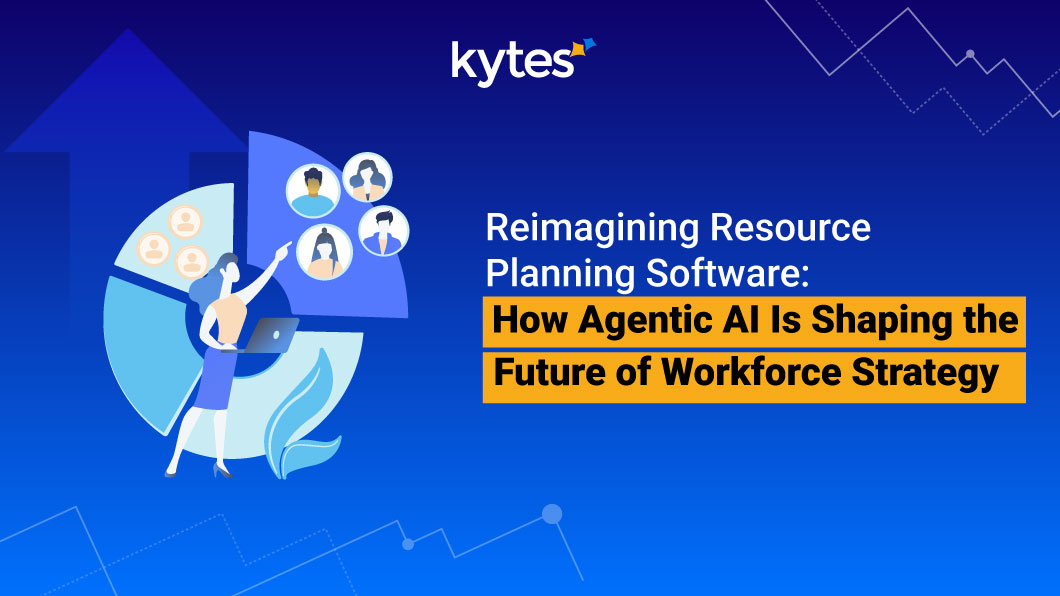Blog Highlights
- Workforce dynamics are shifting as projects become larger, more global, and more complex.
- Traditional tools and manual spreadsheets fall short when it comes to visibility and adaptability.
- Agentic AI elevates resource management by making autonomous decisions in real time.
- Kytes embeds this intelligence into its PSA + PPM platform to unify people, projects, and profitability.
- Strategic benefits include higher margins, better utilization, improved forecasting, and stronger client satisfaction.
- Looking ahead, Agentic AI is set to redefine the future of work through intelligent execution.
When a high-stakes project runs behind schedule, leadership often looks at timelines, budgets, or client expectations. Rarely do they begin by asking a more fundamental question: Were the right people on the right work at the right time?
In many cases, they weren’t.
Resource planning remains one of the most overlooked contributors to project success—and failure. Despite being central to profitability, client satisfaction, and employee engagement, it’s still treated as a scheduling problem rather than a strategic function.
But that mindset is shifting. As projects grow more complex and global teams become the norm, the limitations of manual planning and outdated tools are becoming impossible to ignore. Enterprises are recognizing the need for smarter, more adaptive approaches—and increasingly turning to resource planning software powered by artificial intelligence.
A Shifting Workforce Landscape
Resource planning has traditionally involved matching availability with project needs using static spreadsheets or isolated tools. Although manageable in smaller environments, these methods falter under the weight of scale and complexity.
Studies show that while 92% of organizations store employee skill data, only 60% maintain it in a way that enables accurate planning. This results in common—but costly—inefficiencies:
- Bench time even during high demand
- Overloading critical talent
- Skill mismatches leading to rework
- Delays in delivery and billing cycles
The cost of poor planning isn’t always visible upfront, but it shows up later—as revenue leakage, missed targets, and reduced client satisfaction
Why Traditional Tools Are No Longer Enough
Despite growth in enterprise resource planning system software, many organizations still manage resources through fragmented processes or generic tools not designed for dynamic project environments. These systems lack visibility, adaptability, and real-time decision-making capabilities.
The limitations are clear:
- Skills databases remain outdated or incomplete
- Decisions are influenced by subjective preferences
- Forecasting fails to account for upcoming demand shifts
What businesses need is not just automation, but intelligence. Not just tracking, but strategy.
From Automation to Intelligence: The Role of Agentic AI
AI has been assisting planning functions for some time now—but Agentic AI takes this further. It’s designed not just to support human decision-making, but to act on its own. It monitors variables in real time and dynamically allocates resources based on project priorities, skill availability, cost impact, and historical performance.
By combining real-time data with autonomous actions, Agentic AI can:
- Minimize bench time
- Optimize billable utilization
- Flag capacity or skill gaps before they impact delivery
- Align resources to both project fit and profitability
This capability is fast becoming a differentiator. In 2024, over 60% of project managers reported improved delivery timelines and resource outcomes after adopting AI-powered tools.
Embedding Agentic AI into Resource Planning: The Kytes Approach
At Kytes, we’ve built our agentic AI and autonomous PSA + PPM to do more than just track availability. It’s designed to help project-based companies strategically align their workforce with business outcomes—across industries like IT/ITES, consulting, pharmaceuticals, and global capability centers (GCCs).
Some of the key capabilities include:
- Predictive Allocation
Agentic AI continuously monitors project pipelines, skills, and workload balance to assign the right resource to the right project in real time. - Skills Intelligence & Resume Automation
Skills data is dynamically updated from project records, external sources like LinkedIn, and resume approvals—ensuring every profile is complete and accurate. - Contractual Resource Management
Track, forecast, and deploy external or short-term resources with built-in approval workflows and compliance checks. - Multi-Country Compliance & Leave Management
Automate local compliance needs and maintain visibility across global teams to avoid billing disruptions. - Integrated Financial Planning
Align project delivery with billing and revenue recognition through seamless integration with ERP, HRMS, CRM, and financial systems. - Forecasting & Scenario Planning
Use predictive models to anticipate skill shortages, overutilization, or demand surges—then respond proactively.
By integrating resource management into the broader delivery and financial ecosystem, Kytes enables organizations to move from reactive firefighting to proactive planning.
Strategic Benefits Beyond Efficiency
The impact of effective resource planning extends well beyond operational efficiency. With intelligent systems in place, organizations experience:
- Fewer delivery delays and better client experience
- Improved profitability through optimized utilization and reduced idle time
- Lower attrition as employees are assigned roles aligned with skills and interests
- Greater forecasting accuracy for capacity, hiring, and financial planning
- Stronger internal coordination across delivery, finance, and HR functions
As workforce strategies become more central to business performance, organizations that invest in adaptive, AI-enabled planning will gain a lasting competitive advantage.
The Future of Work
Resource planning is no longer just about operational coordination—it’s about strategic foresight. With teams spread across geographies, skills evolving rapidly, and project scopes becoming more fluid, organizations need planning systems that are just as dynamic.
Agentic AI brings a new dimension to workforce management. It turns resource planning into a living, responsive system—continuously aligning people, projects, and profitability.
At Kytes, we believe that sustainable growth is driven by intelligent execution. That’s why our PSA + PPM platform brings together AI-powered insights, industry-specific best practices, and seamless integrations to help organizations plan better, adapt faster, and execute smarter. Schedule a demo to explore how Kytes can help your teams become more agile, aligned, and future ready.





